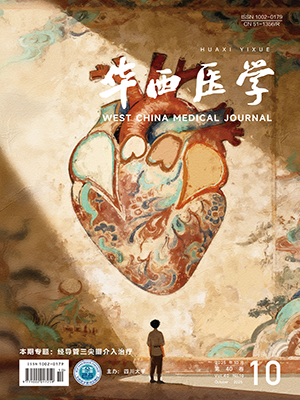| 1. |
Doi Y. Treatment options for carbapenem-resistant Gram-negative bacterial infections. Clin Infect Dis, 2019, 69(Suppl 7): S565-S575.
|
| 2. |
Nordmann P, Poirel L. Epidemiology and diagnostics of carbapenem resistance in Gram-negative bacteria. Clin Infect Dis, 2019, 69(Suppl 7): S521-S528.
|
| 3. |
Zong Z, Feng Y, McNally A. Carbapenem and colistin resistance in Enterobacter: determinants and clones. Trends Microbiol, 2021, 29(6): 473-476.
|
| 4. |
Tooke CL, Hinchliffe P, Bragginton EC, et al. β-lactamases and β-lactamase inhibitors in the 21st century. J Mol Biol, 2019, 431(18): 3472-3500.
|
| 5. |
Lohans CT, Brem J, Schofield CJ. New Delhi metallo-β-lactamase 1 catalyzes avibactam and aztreonam hydrolysis. Antimicrob Agents Chemother, 2017, 61(12): e01224-17.
|
| 6. |
Ehmann DE, Jahic H, Ross PL, et al. Kinetics of avibactam inhibition against class A, C, and D β-lactamases. J Biol Chem, 2013, 288(39): 27960-27971.
|
| 7. |
Mendes RE, Doyle TB, Streit JM, et al. Investigation of mechanisms responsible for decreased susceptibility of aztreonam/avibactam activity in clinical isolates of Enterobacterales collected in Europe, Asia and Latin America in 2019. J Antimicrob Chemother, 2021, 76(11): 2833-2838.
|
| 8. |
Yamamoto S, Harayama S. PCR amplification and direct sequencing of gyrB genes with universal primers and their application to the detection and taxonomic analysis of Pseudomonas putida strains. Appl Environ Microbiol, 1995, 61(3): 1104-1109.
|
| 9. |
Delmas J, Breysse F, Devulder G, et al. Rapid identification of Enterobacteriaceae by sequencing DNA gyrase subunit B encoding gene. Diagn Microbiol Infect Dis, 2006, 55(4): 263-268.
|
| 10. |
Clinical and Laboratory Standards Institute. Performance standards for antimicrobial susceptibility testing; thirtieth informational supplement. M100-S30. Wayne: Clinical and Laboratory Standards Institute, 2022.
|
| 11. |
Clinical and laboratory Standards Institute. Methods for determining bactericidal activity of antimicrobial agents; approved guideline. M26-A. Wayne: Clinical and laboratory Standards Institute, 1999.
|
| 12. |
Wu S, Zong Z. Aztreonam-avibactam: an option against carbapenem-resistant Enterobacterales with emerging resistance. Precis Clin Med, 2022, 5(4): pbac029.
|
| 13. |
孙玥, 郑永贵, 隗志翔, 等. 头孢他啶-阿维巴坦对肠杆菌科细菌和铜绿假单胞菌的体外杀菌活性研究. 中国感染与化疗杂志, 2021, 21(3): 314-318.
|
| 14. |
Fan Y, Li Y, Chen Y, et al. Pharmacokinetics and pharmacodynamics of colistin methanesulfonate in healthy chinese subjects after multi-dose regimen. Antibiotics (Basel), 2022, 11(6): 798.
|
| 15. |
Davin-Regli A, Lavigne JP, Pagès JM. Enterobacter spp. : update on taxonomy, clinical aspects, and emerging antimicrobial resistance. Clin Microbiol Rev, 2019, 32(4): e00002-19.
|
| 16. |
Wang Q, Wang X, Wang J, et al. Phenotypic and genotypic characterization of carbapenem-resistant Enterobacteriaceae: data from a longitudinal large-scale CRE study in China (2012-2016). Clin Infect Dis, 2018, 67(Suppl 2): S196-S205.
|
| 17. |
Zhang R, Liu L, Zhou H, et al. Nationwide surveillance of clinical carbapenem-resistant Enterobacteriaceae (CRE) strains in China. EBioMedicine, 2017, 19: 98-106.
|
| 18. |
Cai Y, Chen C, Zhao M, et al. High prevalence of metallo-β-lactamase-producing Enterobacter cloacae from three tertiary hospitals in China. Front Microbiol, 2019, 10: 1610.
|
| 19. |
Paul M, Carrara E, Retamar P, et al. European Society of Clinical Microbiology and Infectious Diseases (ESCMID) guidelines for the treatment of infections caused by multidrug-resistant Gram-negative bacilli (endorsed by European Society of Intensive Care Medicine). Clin Microbiol Infect, 2022, 28(4): 521-547.
|
| 20. |
Tamma PD, Aitken SL, Bonomo RA, et al. Infectious Diseases Society of America guidance on the treatment of extended-spectrum β-lactamase producing Enterobacterales (ESBL-E), carbapenem-resistant Enterobacterales (CRE), and Pseudomonas aeruginosa with difficult-to-treat resistance (DTR-P.aeruginosa). Clin Infect Dis, 2021, 72(7): 1109-1116.
|
| 21. |
Sader HS, Carvalhaes CG, Arends SJR, et al. Aztreonam/avibactam activity against clinical isolates of Enterobacterales collected in Europe, Asia and Latin America in 2019. J Antimicrob Chemother, 2021, 76(3): 659-666.
|
| 22. |
Wang X, Zhang F, Zhao C, et al. In vitro activities of ceftazidime-avibactam and aztreonam-avibactam against 372 Gram-negative bacilli collected in 2011 and 2012 from 11 teaching hospitals in China. Antimicrob Agents Chemother, 2014, 58(3): 1774-1778.
|
| 23. |
Mauri C, Maraolo AE, Di Bella S, et al. The revival of aztreonam in combination with avibactam against metallo-β-lactamase-producing Gram-negatives: a systematic review of in vitro studies and clinical cases. Antibiotics (Basel), 2021, 10(8): 1012.
|
| 24. |
Bocanegra-Ibarias P, Camacho-Ortiz A, Garza-González E, et al. Aztreonam plus ceftazidime-avibactam as treatment of NDM-1-producing Klebsiella pneumoniae bacteraemia in a neutropenic patient: last resort therapy?. J Glob Antimicrob Resist, 2020, 23: 417-419.
|
| 25. |
Hong YK, Lee JY, Ko KS. Colistin resistance in Enterobacter spp. isolates in Korea. J Microbiol, 2018, 56(6): 435-440.
|
| 26. |
Ma K, Feng Y, McNally A, et al. Struggle to survive: the choir of target alteration, hydrolyzing enzyme, and plasmid expression as a novel aztreonam-avibactam resistance mechanism. mSystems, 2020, 5(6): e00821-20.
|
| 27. |
Satapoomin N, Dulyayangkul P, Avison MB. Klebsiella pneumoniae mutants resistant to ceftazidime-avibactam plus aztreonam, imipenem-relebactam, meropenem-vaborbactam, and cefepime-taniborbactam. Antimicrob Agents Chemother, 2022, 66(4): e0217921.
|




